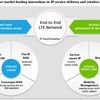By Mae Kowalke
Mobile network operators are always looking for new ways to more efficiently use their existing infrastructure without making large capital expenditures. With the explosion of tablets and smartphones, which will increasingly be used for a variety of video applications, streamed as well as interactive, use of a 4G LTE channel for delivering multicast services such as mobile TV is viewed as one way to do so. The reason is simple. It enables network operators to offer mobile TV without the need for additional expensive licensed spectrum and without requiring new infrastructure and end-user devices that might be required to unicast content.
A recent Alcatel-Lucent TechZine article, “eMBMS for More Efficient Use of Spectrum,” describes the enhancements to LTE specifications that have been standardized to accommodate rapidly changing user demands and concomitant network requirements. Evolved Multimedia Broadcast Multicast Service (eMBMS) is now a multicast standard for 4G LTE precisely because it allows one-to-many distribution of video content.
“For example, during live streaming of major sports or news events, unicast must send the same video to every user individually,” explain RJ Vale, Network Architect for Alcatel-Lucent’s corporate CTO technology advisory group, and Harish Viswanathan, CTO advisor on devices and machine-to-machine (M2M) technology for Alcatel-Lucent. The authors state that eMBMS makes licensed spectrum usage more efficient by leveraging multicast capabilities. These capabilities, “take advantage of the inherent broadcast qualities of wireless networks to send video only once to reach an equal number of end users.” This reduces the cost per bit sent.
The authors’ detail why the underlying structure of eMBMS is what makes it more efficient.
The example given puts the numbers in stark relief. “In one-to-many transmissions, a large number of mobile devices can tune in and receive the video from a single transmission…So, if eight mobiles within a sector all want the same content, multicast can transmit it just once. But unicast would have to transmit it eight times — using on the order of eight times the resources that would be required in multicast.” In addition, eMBMS sessions can be set up dynamically to share resources using unicast sessions, operating on a single frequency across a group of cells to improve reception.
Initial deployments of eMBMS, a standard supported by 3GPP R9, are slated to begin this year (2012). As the article highlights, eMBMS can be used to expand the capabilities of LTE networks by using the same frequency layer for multicast, broadcast and unicast. This goes to the heart as to how and why operators can not only save money and but also provide an improved customer experience because of better reception and throughput.
eMBMS deployments, Vale and Viswanathan note, involve a somewhat complex interplay of network elements:
- Broadcast/Multicast Service Center (BM-SC) – schedules and manages MBMS services
- Multimedia Broadcast Multicast Service Single Frequency Network (MBSFN) Area – group of cells that coordinates MBSFN transmission
- Multimedia Broadcast Multicast Services Gateway (MBMS-GW) – sends IP multicast packets, performs session control
- Evolved Node B (eNB) and Mobile Management Entity (MME) – existing elements in LTE
- Multi-cell/Multicast Coordinated Entity (MCE) – function that performs admission control, radio resources allocation and session control signaling
- SYNC Protocol –identifies radio frame transmission timing, detects packet loss
- M2 and M3: signaling interfaces
With these elements rolled together into a solution, eMBMS provides a valuable alternative to unicast for distributing a variety of preloaded and live multimedia content.
In addition to the inherent cost savings derived from content delivery being one-to-many instead of one-to-one, as stated above the fact that eMBMS sessions can be set up dynamically — and share resources with unicast sessions — eliminates the need for dedicated spectrum. Lower cost of using a scarce and expensive resource and a better customer experience sounds like a solution that is likely to be in the future of many of us.










